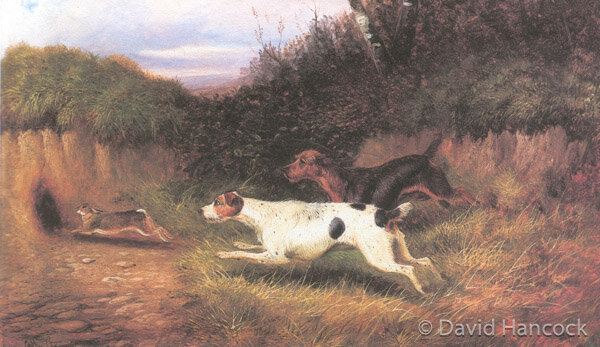1108
A FEW WORDS ON TERRIERS
By David Hancock
Words on terriers, when compared to the other groups of sporting dogs - hounds and gundogs especially, are comparatively few. Books devoted to terriers are a relatively recent addition to our sporting bookshelves. In 1896, in his preface to the first edition of his ‘A History and Description of the Modern Dogs of Great Britain and Ireland: The Terriers’, Rawdon Lee wrote: ‘This, I believe, is the first occasion upon which a volume has been published dealing entirely with the Terriers.’ He wrote this at a time when the bookshelves were stacked with books on setters and scenthounds, and when the show ring was inspiring a new range of books on companion or Toy dogs. But the early writers on dogs were not only remote from their identity but even more so from their role - how they performed in the field, what actually shaped them.
In his Field Sports of 1760, terriers are described by William Daniel as being of two sorts, one of them rough, short-legged, long backed and very strong, usually black or light tan colour, mixed with white. The other was said to be smooth-haired and more pleasingly formed, with a shorter body and a more athletic appearance, usually reddish-brown or black with tan legs. Forty years later, in his Cynographia Britannica, Sydenham Edwards was writing on terriers: "...he will trace with the foxhound, hunt with the beagle, find for the greyhound or beat with the spaniel...he drives the otter..." adding comments on engaging badgers and hunting rats. He also states, almost ominously, "Much of the variety in the Terrier arises from his being a small Dog, and often bred for mere fancy." This latter feature, within a century, had changed many types of terrier for all time. It was 'show time!'
In his book, mentioned above, Rawdon Lee went on to write: ‘In describing the Terriers in all their varieties, I have endeavoured to give particulars as to their working qualifications and their general character, as well as their so-called “show points”; and my desire to prevent, if possible, a useful race of dog from degenerating into a ladies’ pet and a pampered creature, only able to earn his owner gold on the show bench, is my reason for treating so fully of him as he is concerned in that sphere which Nature intended him to occupy.’ That last phrase is the key; terriers often make good ladies’ pets and the show bench has saved some terrier breeds from oblivion, but whatever their role, terriers deserve to be perpetuated in their authentic, functional form. This is, truly, as Rawdon Lee so picturesquely put it ‘that sphere which Nature intended him to occupy’.
Quaint words from the past, and nearly a century apart, tell you a great deal about the collection of sporting dogs grouped together as terriers, not just their purpose but their size, character and role in the hunting field too. I have long expressed my admiration for the group of dogs known as terriers, their impudent appeal, their perpetual optimism, their renowned tenacity and their sheer vivacity. But I have long argued too for a return, especially in the show dogs, to their functional form: a build which would allow them to perform in the field, even if they are not required to; traditional head shapes not fad-induced ones; good forward extension not restricted reach; weatherproof coats not fluffy woolly ones and, in particular, for the encouragement of their sporting instincts. In his The Dog in Sport of 1938, James Wentworth Day, makes this point rather well: “There are terriers of sorts which through long usage as house-dogs and pets have lost most of their essential qualities as outdoor working companions for the man with a gun. But in spite of this decline in their native gifts – no fault of their own – they still preserve the gallant spirit of less urbanized ancestors, and most of them, with a little training and opportunity, can easily be turned into first-rate rabbiters, ratters and fox-bolters.”
The terriers as a functional group are essentially British, with the distinguished breeds from Scotland, Ireland and Wales combining with those of England to give the canine world the much-loved terrier breeds valued everywhere. A long history is often claimed for breeds of terrier, but I doubt if terrier men in past centuries ever bothered much about pure breeding. In his The Book of all Terriers of 1971, John Marvin writes: "Despite claims made by writers who champion the antiquity of several of today's Terrier breeds, years of careful research have failed to disclose a single reference to any reproducible breed prior to 1800. In fact, the only deviations from the earliest descriptions are variations noted as to coat, size and legs."
But, whatever the origin, the nomenclature or the lack of literature behind the terrier type, this group of dogs deserves our admiration, not just for their valuable work in vermin control but for their effect on our spirit; it is difficult to be depressed, idle or bored when terriers are about. Their sheer joie de vivre lightens our day, their renowned tenacity can inspire us and their sustained curiosity can shame us into comparable activity. May we have real terriers with us for a very long time.











